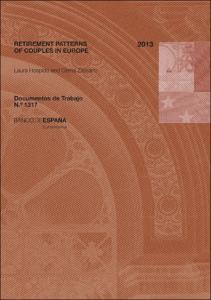Retirement patterns of couples in Europe
Autor
Fecha de publicación
12-nov-2013
Descripción física
31 p. : gráf., tab.
Resumen
En este trabajo analizamos las pautas de jubilación de parejas en el contexto europeo utilizando datos de la Survey of Health, Aging and Retirement in Europe (SHARE). En concreto, evaluamos si las salidas del mercado de trabajo de las mujeres (hombres) están causadas por el hecho de que sus maridos (mujeres) dejen de trabajar, usando la variación institucional en las edades oficiales de jubilación (anticipada y normal) específicas de cada país como instrumento. Explotando las discontinuidades en los incentivos a la jubilación de cada país, encontramos que la jubilación de los maridos tiene un efecto significativo de entre 16 y 18 puntos porcentuales en la probabilidad de dejar de trabajar de sus mujeres. Para los hombres el efecto es similar en magnitud, pero no es estadísticamente significativo. Este efecto indirecto de la jubilación conjunta puede tener importantes consecuencias para la implementación de reformas
In this paper we study the retirement patterns of couples in a multi-country setting using data from the Survey of Health, Aging and Retirement in Europe. In particular, we test whether women’s (men’s) transitions out of the labor force are causally related to the actual realization of their husbands’ (wives’) transition, using the institutional variation in country-specific early and full statutory retirement ages to instrument the latter. Exploiting the discontinuities in retirement behavior across countries, we find a significant joint retirement effect, especially for women, of around 16 to 18 percentage points. For men, we find a similar but less precise effect. Our empirical strategy allows us to give a causal interpretation to the effect we estimate. In addition, this effect has important implications for policy analysis
In this paper we study the retirement patterns of couples in a multi-country setting using data from the Survey of Health, Aging and Retirement in Europe. In particular, we test whether women’s (men’s) transitions out of the labor force are causally related to the actual realization of their husbands’ (wives’) transition, using the institutional variation in country-specific early and full statutory retirement ages to instrument the latter. Exploiting the discontinuities in retirement behavior across countries, we find a significant joint retirement effect, especially for women, of around 16 to 18 percentage points. For men, we find a similar but less precise effect. Our empirical strategy allows us to give a causal interpretation to the effect we estimate. In addition, this effect has important implications for policy analysis
Publicado en
Documentos de Trabajo / Banco de España, 1317
Materias
Jubilación conjunta; Incentivos de la Seguridad Social; Joint retirement; Social security incentives; Seguridad social y programas de asistencia social; Modelos econométricos; Europa
Aparece en las colecciones:












